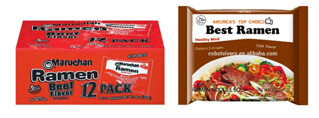
PREV ARTICLE
NEXT ARTICLE
FULL ISSUE
PREV FULL ISSUE
MORE ON NOODLE MONEY IN AMERICAN PRISONSSpeaking of primitive money, the March 2017 newsletter of the International Primitive Money Society (IPMS) notes that an IPMS meeting at the ANA National Money Show next month in Orlando, FL will feature President Charles Opitz, who will present a program on “Kesa, a form of traditional money from Choisoul Island in the Solomon Islands. The meeting will take place Friday March 10, 2017 at 1pm. Also in the latest IPMS Newsletter is this article by Bob Leonard on noodle money in American prisons, a topic we covered on August 28, 2016 after the Washington Post article was originally published. With permission, here's Bob's article in its entirety. -Editor NOODLE MONEY IN AMERICAN PRISONS
She reports that Michael Gibson-Light, a doctoral candidate in the University of Arizona School of Sociology, has completed a new study indicating that instant ramen noodles are overtaking tobacco as the preferred underground currency for prison inmates. Their main advantage? They are nonperishable, “ludicrously cheap,” easy to cook, and delicious. Ah, but there may be political overtones here. Gibson-Light issued a press release on his study claiming that “Prisoners are so unhappy with the quality and quantity of prison food that they receive that they have begun relying on ramen noodles—a cheap, durable food product—as a form of money in the underground economy. Because it is cheap, tasty and rich in calories, ramen has become so valuable that it is used to exchange for other goods.” Gibson-Light based his conclusion on interviews with 60 male inmates and staff members at a single state-run facility over a year’s time. Not surprisingly, he heard gripes about the cuisine at this institution. He then factored them in to a larger investigation into how prisoners were responding to “declining prison services,” claiming to have uncovered “punitive frugality,” that is, the cost of care shifting on to prisoners and their support networks because of shrinking corrections budgets. At this particular institution, about 15 years ago, hot lunches were replaced by a sandwich and a bag of chips, and portion sizes reduced, he was told. Turning away from the advocacy aspect of this study, one inmate told Gibson-Light why ramen noodles were desired: “It’s ‘cause people are hungry. You can tell how good a man’s doing [financially] by how many soups he’s got in his locker. ‘Twenty soups? Oh, that guy’s doing good!’” Gibson-Light referred to this as a “prison ramen black market.” Wang also quoted Gustavo “Goose” Alvarez, co-author of Prison Ramen: Recipes and Stories from Behind Bars, published November 2015. “Goose” spent time in prison twice, once in the mid ’90s and again from 2006 to 2013. “He quickly learned how critical ramen was to the inmate economy....‘It’s gold. It’s literally gold,’ Alvarez told The Washington Post. ‘People will actually—and I hate to say this but—they’ll kill for it, believe it or not.’” “Alvarez said he never ate ramen before incarceration but quickly discovered that the cheap bricks were a no-brainer purchase at the prison commissary if he wanted to stretch his account. ‘It got to the point where some people would rather have a decent meal than a stogie, especially the way they’re feeding us in prison.’” Like any currency, the value of a ramen pack fluctuated. “‘I remember in ’92, you could get them for 20 cents a ramen,’ Alvarez said. ‘In 2013, the last time I was in prison, they were equivalent to $1 a ramen, sometimes $2.’” Now living in Playas de Tijuana, Mexico, “Goose” does not associate ramen with prison; “His pantry is full of packs of Maruchan, still his go-to brand,” which he buys at Walmart. Ramen was invented in 1958 by Taiwanese- Japanese entrepreneur Momofuku Ando and soon became popular worldwide. It is now a multibillion- dollar industry, according to Wang. Your editor observes that ramen was already a popular prison currency a decade before hot lunches were eliminated at the state institution Gibson-Light visited. Also, smoking has been in decline in the United States for many years, clearly reducing the desirability of cigarettes as an alternative currency, even though it was permitted at the institution Gibson-Light saw.
While I'm at a loss to see how politics comes into any of this, I agree that human choices are generally driven by a complicated and often subtle mix of forces. I remember wondering myself about the decline of smoking in the rise of the noodle, and what practices would be found in a wider sampling of institutions.
-Editor
Bob adds: My account is skeptical in some respects, because the sociology student who did the study seemed to have an axe to grind.
To read the complete article, see:
The Numismatic Bibliomania Society is a non-profit organization promoting numismatic literature. See our web site at coinbooks.org. To submit items for publication in The E-Sylum, write to the Editor at this address: whomren@gmail.com To subscribe go to: https://my.binhost.com/lists/listinfo/esylum All Rights Reserved. NBS Home Page Contact the NBS webmaster 
|
